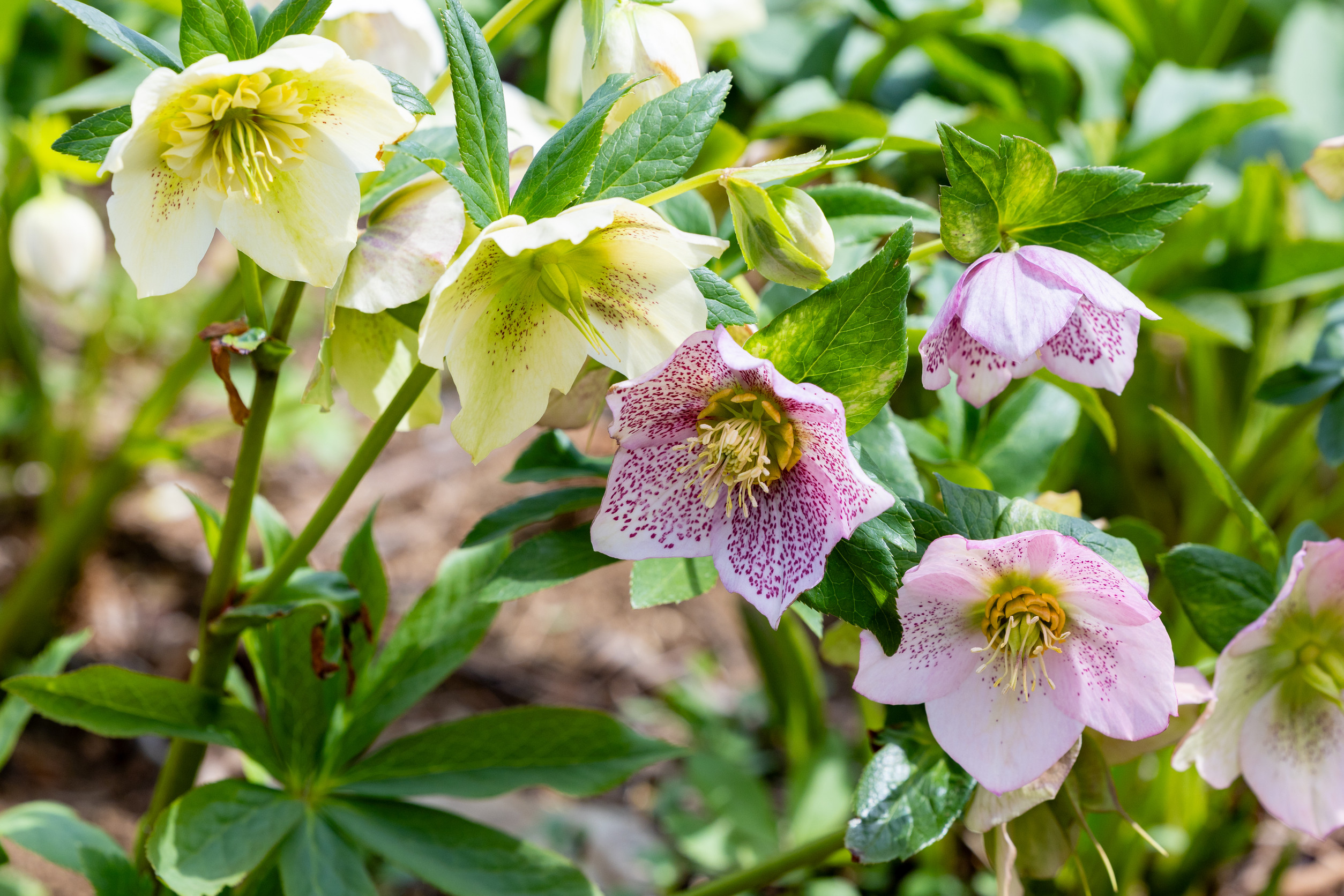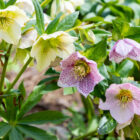
Hellebore, a fascinating winter flower
Hellebore, one of the most fascinating and dangerous winter flowers, both for your balconies and gardens
 The Hellebore is a perennial plant that fascinates with its hardiness and surprising ability to flower during the winter months, when many other plants are dormant. A member of the Ranunculaceae family, Hellebore plants are famous for their showy flowers and leathery leaves, making it a distinctive feature in winter gardens.
The Hellebore is a perennial plant that fascinates with its hardiness and surprising ability to flower during the winter months, when many other plants are dormant. A member of the Ranunculaceae family, Hellebore plants are famous for their showy flowers and leathery leaves, making it a distinctive feature in winter gardens.
Despite its beauty, Hellebore is also a toxic plant. This aspect contributed to forming an aura of mystery and linked it to numerous legends and popular beliefs. Its resistance to the cold and its early flowering also make it a popular plant. This is true especially for those who wish to brighten up their gardens even during the greyest periods of the year.
Hellebore meaning and features
Etymologically, Hellebore probably derives from the union of two Greek words. The first is helein meaning to wound and borà meaning food. A valid translation could therefore be ‘deadly food/wounding’. At this point, it is clear that the very origin of the term refers to its poisonous potential.
Botanical characteristics of the hellebore
The hellebore flower is famous for its extraordinary ability to bloom during the colder months, illuminating gardens and landscapes with its elegant and hardy flowers. Its morphology and natural habitat make it a unique and fascinating plant, ideal for winter gardeners.
Morphological description
The hellebore is a robust plant with a rhizomatous root system that enables it to survive even in difficult conditions. Its leaves, often persistent, are leathery and deep green, sometimes shiny, with a palmate or lobed shape that adds a touch of elegance to the plant. The flowers, the true protagonists, are of a sober and refined beauty. They are cup-shaped and can reach a diameter of 5-8 cm. What we call ‘petals’ are actually coloured sepals, ranging from snow-white to soft pink, from green to dark purple, depending on the species. The actual petals, on the other hand, have turned into nectaries to attract pollinating insects. Flowering, which occurs between December and March, is a rare sight in the heart of winter. After flowering, hellebores produce fruit in the form of follicles, containing small, shiny black seeds, which often self-disseminate, promoting the spontaneous spread of the plant.
Habitat and geographical distribution
Hellebores are native to various regions of Europe and Asia Minor, but can also be found in the mountainous areas of the Caucasus. It prefers cool, shady environments such as deciduous woods, forest edges and mountain meadows, where it grows up to an altitude of 1,500 metres. It likes calcareous, well-drained soils rich in organic matter, which provide it with ideal conditions to thrive. Although it is a hardy plant, hellebores prefer semi-shaded locations, away from direct sunlight during the hottest hours. Geographically, Helleborus niger is mainly found in the Alps and the Carpathians, while Helleborus orientalis is found in the Balkans and Asia Minor. Helleborus foetidus, on the other hand, is common in the forests of Western Europe, where it grows wild along hedges and roadsides.
Varieties and species of Hellebore
Hellebores are a genus comprising numerous species and varieties. Each has unique characteristics that make them suitable for different environments and uses. These plants not only fascinate with their ability to flower in mid-winter, but also offer an amazing variety of shapes, colours and adaptations.
Main types
Among the most famous species there are:
- Helleborus niger: the Christmas rose or commonly black hellebore is perhaps the most famous species. It is distinguished by its large white flowers with pink hues that bloom between December and January. It is a symbol of purity and hope and is particularly valuable for its ability to resist frost.
- Helleborus orientalis: native to the Balkans and Anatolia, it is also known as eastern hellebore. This species offers a wide range of colours, from cream and pink tones to greens and dark purples. Its versatility makes it one of the most widely in use for creating ornamental hybrids.
- Helleborus foetidus: The name stink hellebore is due to the faint odour emitted by its leaves. In fact, this species has green flowers with purple edges, often grouped in clusters. It is ideal for shady gardens and adapts well to poorer soils.
- Helleborus argutifolius: native to Corsica, it stands out for its leathery leaves and light green flowers. It is a robust plant, adapted to warmer climates than other species.
- Helleborus viridis: a wild species that produces bright green flowers. It is less common in cultivation, but has a special charm for those who appreciate rustic, natural plants.
Differences and peculiarities
The differences between hellebore species do not only relate to the colours and shape of the flowers, but also include aspects related to their adaptation and cultivation.
- Flower colours and shapes: While Helleborus niger is synonymous with elegance with its pure white flowers, Helleborus orientalis offers an extraordinarily wide colour palette, making it perfect for adding a splash of colour to the winter garden.
- Flowering period: Some species, such as Helleborus niger, flower early, as early as December, while others, such as Helleborus orientalis, tend to flower later, towards the end of winter or early spring.
- Adaptability: Helleborus foetidus and Helleborus argutifolius have a reputation for their hardiness and ability to adapt to less fertile soils, while other species require richer soil and specific conditions.
- Ornamental use: Some varieties, such as the hybrid Helleborus orientalis, have been selected for gardening because of their particularly showy and long-lasting flowers. Others, such as Helleborus foetidus, stand out for their ability to create green borders throughout the year.
Properties of hellebore
In addition to its ornamental beauty, hellebore is a plant that fascinates for centuries for its therapeutic properties and traditional uses in phytotherapy. However, it is important to emphasise that it is a poisonous plant, and any therapeutic use requires extreme caution and is for expert hands only.
Therapeutic properties
Hellebores have a long history of use in traditional medicine. Hellebores have in fact purgative, cardiotonic and sedative properties. The roots and rhizomes of some species, in particular Helleborus niger and Helleborus viridis, contain powerful active ingredients, including elborin, elborinaine and glyconitrile. In the past, small doses of hellebore preparations were in use as drastic purgatives to aid the purification of the body. Greek and Roman physicians, including Hippocrates and Pliny the Elder, considered it useful for ‘purifying the mind’ and treating nervous disorders or states of agitation.
Is hellebore poisonous to touch?
All hellebore varieties are toxic to some degree. So, how poisonous is hellebore? Despite its properties, the direct use of hellebore has fallen into disuse due to its dangerousness, which can lead to serious side effects, including poisoning. All its parts are toxic and can cause more or less severe symptoms, such as vomiting, diarrhoea and heart problems, if not dosed correctly. Precisely for this reason, it is now considered an ornamental plant and no longer of therapeutic value.
How do you take care of a hellebore?
The hellebore is a plant popular among gardeners for its hardiness, its ability to flower in winter and its discreet beauty. Hellebore care is relatively simple, as long as certain guidelines are observed. The first option is therefore to plant it in the garden, respecting its nature and placing it in a shaded or half-shaded area. Perhaps one could put it next to other plants that protect it from direct sunlight. The ideal soil should be well drained, moist but not excessively.
Can hellebore be grown in containers?
Another good alternative is to plant hellebores in pots, e.g. on a balcony at home. In this case, it is important not to use containers that are too small. Indeed, they would restrict the space necessary for the plant to grow. It should also be out of direct sunlight and beware of winter frost. As a matter of fact, potted plants are more vulnerable to cold than plants grown in the ground.
Propagation techniques
 To propagate hellebores, one can follow two simple and natural methods. The first consists of spontaneous sowing. Flowers, once they have withered, release their seeds directly onto the surrounding soil, thus encouraging the birth of new plants. The second method is propagation by dividing the mother plant. In this case, one should divide the stocks at the base when the plant is in a vigorous vegetative state. However, always make sure to work carefully to ensure successful transplanting.
To propagate hellebores, one can follow two simple and natural methods. The first consists of spontaneous sowing. Flowers, once they have withered, release their seeds directly onto the surrounding soil, thus encouraging the birth of new plants. The second method is propagation by dividing the mother plant. In this case, one should divide the stocks at the base when the plant is in a vigorous vegetative state. However, always make sure to work carefully to ensure successful transplanting.
Gardening and landscaping
In contemporary times, hellebores are mainly appreciated for their role as ornamental plants. It is one of the few plants that flowers in mid-winter, bringing colour and vitality to gardens and landscapes during the colder season. Thanks to its persistent and decorative foliage, hellebores are often used for shady borders or to fill in spaces under trees and shrubs. It is an excellent choice to give visual continuity to the garden even in the colder months.
Curiosities and legends about hellebores
Not only is hellebore a fascinating plant from a botanical point of view, but it is also full of stories, legends and curiosities that make it even more interesting. Over the centuries, its presence in gardens and traditional remedies has sparked myths and popular beliefs, helping to build an aura of mystery and symbolism around this plant. Since antiquity, it has left traces of its name in the work of the famous Roman poet Titus Maccius Plautus. The term ‘elleborum’ and its medieval variant ‘Helleborus’ testify to the long history of this plant, rich in symbolic meanings and traditions. Known by various popular names, such as Christmas rose, winter rose, oracle flower, devil’s weed or black sneeze root, hellebore has always inspired myths and beliefs. Let’s take a look at the most interesting ones.
The legend of the Christmas rose
According to an old tradition, the name ‘Christmas rose’ is due to a legend linked to the birth of Jesus. A poor shepherd, on his way to Bethlehem, wept because he had no gift to offer the newborn baby. As he walked disconsolately, white and beautiful rose-like flowers sprang up from the icy ground, wet with his tears. Filled with joy, the shepherd picked up those miraculously born roses and brought them as a gift to the baby Jesus.
The black sneezing root: ‘Nieswurz’
In Germany, this name derives from the irritating property of hellebore, which, in its powdery state, induces sneezing due to a substance in the plant. In the past, this peculiarity took place to ‘purify’ the body, causing sneezing that was thought to expel demons or diseases.
Fertilisation of hellebores
 Fertilising is a key practice to ensure the health and beauty of hellebores. This plant, if properly nurtured, can give a lush bloom even in the coldest months. To promote rapid rooting and stimulate the formation of new roots, we recommend applying a root stimulator. For example, apply Top Sinergy directly on the roots during transplanting between September and May.
Fertilising is a key practice to ensure the health and beauty of hellebores. This plant, if properly nurtured, can give a lush bloom even in the coldest months. To promote rapid rooting and stimulate the formation of new roots, we recommend applying a root stimulator. For example, apply Top Sinergy directly on the roots during transplanting between September and May.
 When the Ellebore enters the flowering stage, typically between October and November, Doctor Bioges recommends the application of Bioactivit. It encourages a more explosive flowering, with larger and more voluminous flowers, prolonging its duration.
When the Ellebore enters the flowering stage, typically between October and November, Doctor Bioges recommends the application of Bioactivit. It encourages a more explosive flowering, with larger and more voluminous flowers, prolonging its duration.
 Finally, although Ellebore is a hardy plant, it is sensitive to temperature changes, which can cause stress. In these cases, Furius BZ is a valuable ally. This product helps the plant to develop stronger tissues and strengthen its resistance to stress. This care will ensure a healthy, vigorous plant ready to flower in the most difficult seasons.
Finally, although Ellebore is a hardy plant, it is sensitive to temperature changes, which can cause stress. In these cases, Furius BZ is a valuable ally. This product helps the plant to develop stronger tissues and strengthen its resistance to stress. This care will ensure a healthy, vigorous plant ready to flower in the most difficult seasons.
In conclusion…
The hellebore is a plant that perfectly embodies the combination of beauty, history and mystery. With its extraordinary ability to bloom during the coldest months, it became a symbol of hope and rebirth, bringing colour and vitality even during winter. But besides its undisputed ornamental beauty, hellebore has a long tradition in folk medicine. However, today its use has been abandoned due to its toxicity. The legends surrounding this plant, as well as historical curiosities, remind us how deep and fascinating is its connection to popular culture and beliefs.
From spiritual purification to protection against evil spirits, hellebore has played a significant role in the traditions of many peoples. Today, it remains a valuable plant for gardening and landscaping, thanks to its ability to decorate and enrich gardens with its charming and hardy flowers. In every green corner, whether in a shady garden or in a pot on the balcony, hellebores continue to tell stories of bygone times and provide beauty, while also offering a symbol of perseverance and hope that flourishes even in the most difficult times.
If you have questions or need further information, the Bioges team is always ready to assist you. You can contact us on social network or by sending an e-mail to info@bioges.com.
Stay up to date with our latest news about gardening!




